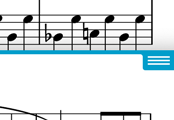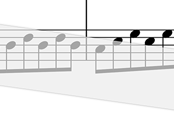Version 14.4.3
The current version of forScore is 14.4.3. If you're experiencing issues while using an older version, updating may help.Otherwise, the easiest way to fix intermittent issues is to quit and relaunch the app. Find out how here.
User Guides
For more in-depth information, check out our user guides.Additional Support
For personalized support, forScore Pro subscribers can contact us directly by opening forScore's Tools menu and choosing 'Support.'If you wish to submit feedback and do not need a response or if you have pre-purchase questions, click here to send us a message.
Please read our support policy here. We are generally unable to provide personalized support and replies are not guaranteed, especially for topics addressed on this page or in our user guide.
Working with the Metronome
Turning pages automatically with Autoturn
For scores with sequential pages, forScore’s metronome can turn the pages for you automatically. To use autoturn, follow these three steps:
- For each page of your score, enter in the number of beats on that page or type in the number of measures and the app will do the math for you. If you’re on the first page of your score, consider adding a few extra beats as a lead-in.
- Tap the autoturn button to turn it on (if it isn’t already)
- Start the metronome by selecting Audible, Visible, or Both
Once the metronome counts up to the number you’ve specified, the page will turn automatically. If you’re viewing your score in landscape mode, forScore will also scroll down when it reaches half of that number. (For example, if you have 64 beats on a page, it’ll scroll to the bottom of the page at 32 beats.)
Turn the metronome off at any point to reset the autoturn count.
Tip: Autoturn relies on a consistent tempo for each page. If your score contains multiple time signatures or significant changes in speed, consider using Replay or a hands-free page turner instead. Please note that Autoturn and Replay are not intended to be used in tandem. We recommend choosing one method or the other.
Understanding forScore’s metronome modes
With forScore’s metronome, you can use several different methods to keep time. In Audible mode, you’ll hear a tick at regular intervals, based on the beats per minute (BPM) that you set. With the Visible metronome, a black border pulses around the edges of your score, allowing you to keep time visually while still being able to see the entire page. If you like, you can use the Both option to both see and hear the metronome simultaneously.
Customizing metronome sounds
With forScore 9 and later, you can customize the metronome “tick” and “tock” sounds to better suit your needs.
- Create or find two .wav files, one for each sound that you’d like to substitute for the defaults
- Add those two .wav files to forScore using any file import method
- Once added, open the tools menu and choose Settings, then Accessibility
- Choose Metronome Sounds, then tap a sound to see a list of compatible .wav files in your library
- Select a file name, then repeat the process for the next sound
- Close the tools menu to save your changes, and the metronome sounds will update automatically
Adjusting the BPM and time signature
For each score in your library, forScore saves a unique BPM value and time signature that’s automatically used every time you return to the metronome feature. Just tap either value to change it with the number keypad. You can also adjust the current score’s BPM by rotating the wheel, using the + and – buttons (available in forScore 10 or later), or by tapping twice in the center of the screen to feel out the beat.
Using Count In to lead off a song
Use the “Count In” feature to automatically turn off the metronome after a certain number of measures. Tap the Count In button to enable it, then set the number of measures by tapping on the value and entering it with the keypad. Once you start the metronome (audible, visible, or both), the app will count out the number of measures specified and stop automatically.
Adjusting the metronome audio channels
If you’re using headphones or a line out with your device, an icon at the top of the panel controls which channel(s) the audio plays through. Tap to toggle between left, right, and both channels.


